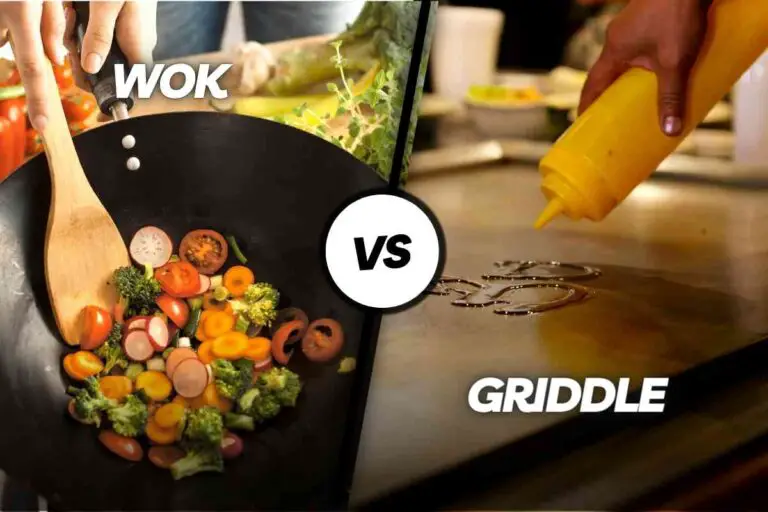How to Season a Wok on Induction Hob: A Beginner-Friendly Guide

A wok is one of the most versatile cooking tools you can own.
Whether you’re stir-frying veggies, making fried rice, or searing meat, a properly seasoned wok enhances flavors and prevents food from sticking.
But if you’re cooking on an induction hob, you might be wondering: can you season a wok the same way you would on gas or electric stoves?
The short answer is yes, but the process has a few important differences.
In this comprehensive guide on how to season a wok on induction hob, we’ll walk you through each step, explain why seasoning matters, and share practical tips to maintain your wok for years to come.
Why Seasoning a Wok is Essential

Seasoning a wok isn’t just a tradition—it’s a necessity.
A seasoned wok develops a natural non-stick coating, also known as a patina, that enhances the flavor of your dishes and protects the metal from rust.
Carbon steel woks, the most common and induction-compatible type, are especially prone to rust if left unseasoned.
If you’re unsure whether carbon steel is right for you, check out this comparison of iron vs. carbon steel woks.
Can You Use a Wok on an Induction Hob?
Before diving into the seasoning process, let’s address the compatibility question.
Not all woks work on induction hobs. Induction cooktops require cookware with a magnetic base.
Flat-bottom carbon steel woks are ideal because they provide consistent contact with the induction surface.
You can learn more about wok compatibility in our detailed guide: Will a wok work on an induction cooktop?
Choosing the Right Wok for Seasoning on Induction
For best results, select a flat-bottom carbon steel wok.
Round-bottom woks won’t sit properly on an induction hob unless you use an induction-compatible wok ring (which isn’t as efficient).
Flat bottoms ensure direct heat transfer, essential for even seasoning.
If you’re still deciding on your first wok, see our recommendations on what wok should I buy.
Step-by-Step Guide: How to Season a Wok on Induction Hob

Let’s break down the seasoning process into manageable steps:
1. Clean the Wok Thoroughly
New woks often come coated with machine oil to prevent rust during shipping.
Wash this off with hot water, mild dish soap, and a scrubber.
For tips on how to do this safely, refer to how to clean a cast iron wok. The principles apply to carbon steel too.
Dry the wok completely using a towel or by heating it on your induction hob for a few minutes.
2. Heat the Wok to Open Its Pores
Turn your induction hob to medium-high heat. As the wok heats, it may change color—this is normal.
You’re heating the metal to open its pores, preparing it to absorb the oil.
Rotate the wok if possible to heat all surfaces evenly, especially if your induction zone is smaller than the wok base.
3. Apply a Thin Layer of Oil
Once hot, apply a high smoke point oil like grapeseed, flaxseed, or peanut oil.
Use a paper towel or heat-resistant brush to spread the oil thinly over the entire surface, inside and out.
Avoid oils with low smoke points, which may burn and create a sticky residue.
4. Heat the Oiled Wok on Induction
Turn the heat back on and let the oil polymerize. You’ll see smoke rising—this is normal and part of the seasoning process.
To minimize kitchen smoke, check out our tips on how to reduce smoke when cooking with cast iron.
Let the wok smoke for about 10 minutes. Rotate as needed for even seasoning.
5. Cool and Repeat
Turn off the hob and let the wok cool naturally. You’ve completed one layer of seasoning.
For best results, repeat the oiling and heating process 2 to 4 more times.
With each layer, your wok will develop a deeper patina and improve its non-stick quality.
Common Mistakes to Avoid
- Using Too Much Oil: This leads to sticky patches instead of a smooth patina.
- Not Heating the Wok Enough: Proper heat is essential to polymerize the oil correctly.
- Skipping Cleaning Before First Use: Factory oils and residues must be removed first.
- Using the Wrong Wok: A round-bottom wok or non-magnetic wok won’t work efficiently on induction.
Maintaining Your Seasoned Wok

Seasoning isn’t a one-time process; it builds up over time.
With every stir-fry or sear, your wok’s seasoning improves.
To maintain it:
- Clean gently with warm water and a soft sponge.
- Avoid harsh detergents or metal scrubbers.
- Dry immediately after washing.
- Lightly oil the surface before storing.
If you’re curious about food storage, explore our post on how to store food in cast iron cookware.
Troubleshooting: What If Your Wok Loses Its Seasoning?
If your wok develops rust spots or loses its non-stick surface, don’t worry.
Simply repeat the seasoning process from the start.
Over time, your wok will develop a rich, dark patina.
To learn what this should look like, visit what should my wok patina look like.
Should You Season Other Types of Woks the Same Way?
Carbon steel woks require seasoning, but stainless steel and enameled cast iron woks do not.
If you’re comparing materials, check out our comparison of wok vs. cast iron skillet.
If you’re curious about seasoning other cookware types, you might also like our article on seasoning a cast iron Dutch oven.
Tips for Cooking on an Induction Hob with a Seasoned Wok
Once seasoned, your wok is ready for all your favorite recipes. Here are a few cooking tips:
- Use medium to medium-high heat; induction hobs heat quickly.
- Preheat your wok before adding oil or ingredients.
- Stir-fry small batches to prevent steaming.
- If you’re wondering what else you can cook besides stir-fries, check out what can you cook in a wok besides stir fry.
Can You Deep Fry in a Wok on Induction?
Yes! A seasoned wok is excellent for deep frying because its sloped sides help control splatter.
Curious about alternatives? Read our deep dive on can wok be used for deep frying.
Final Thoughts on How to Season a Wok on Induction Hob
Seasoning a wok may seem intimidating at first, but once you understand the steps, it becomes second nature.
Whether you’re a home cook or an aspiring wok master, learning how to season a wok on induction hob helps you get the most from your cookware.
Invest in the right wok, follow the seasoning steps, and enjoy countless flavorful meals from your induction kitchen.
For further reading, check out our detailed guide on how to season a wok on an electric stove—many of the techniques apply to induction cooking as well.






